Equipment Sarmatian Auxiliar
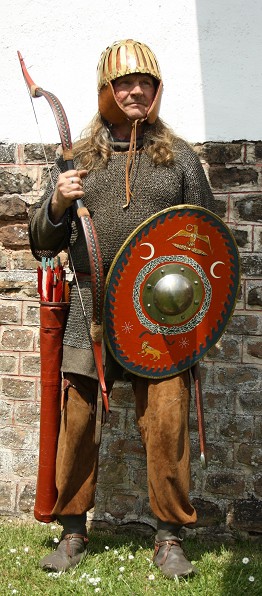 Unless otherwise stated, the objects shown are reproductions of the original state. If features such as color, object parts etc. were added by us, it is noted.
Unless otherwise stated, the objects shown are reproductions of the original state. If features such as color, object parts etc. were added by us, it is noted.
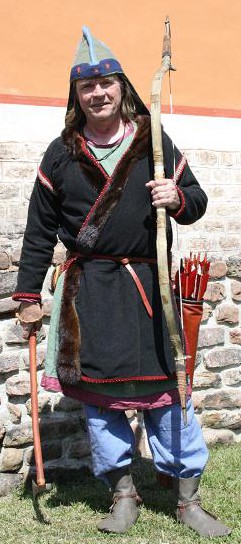
Garment
The main knowledge about Sarmatian garment came to us through pictures. As textiles in the Black Sea region are mostly passed away. Complete garments are not obtained, but on reliefs you can see that they were hardly distinguishable from those of the Scythians and other Eurasian nomads: as outerwear one wore a belted retractable coat whose hem runs straight and has not the typical “tips” of the Scythian coats. At the legs one wore pants which were useful for riding and were made of fabric or leather. Optionally in addition, the nomads protected themselves by a heavy cloak, which was held by a fibula. On the feet the Sarmatian horsemen wore short riding boots made of leather, which were fixed with straps on both feet. They are similar in so far as the Scythian boots.read on...
Literature:
Tolstikov 2013: 222.
Trofimova 2007: 182.
Seipel 2009: 135.
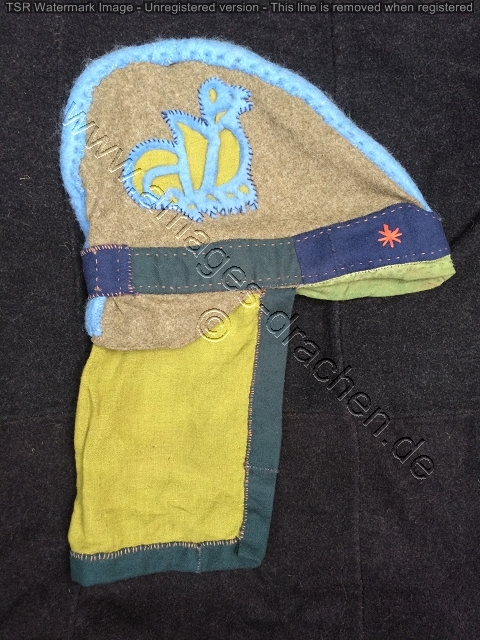 Cap
Cap
Generally the images of Sarmatians show men bareheaded. Nevertheless, it seems likely that the nomads would not only protect their head, but also decorate it. Interesting in this context are two grave stones of the Crimea, which date to the end of the 1st or in the beginning of the 2nd century AD and may represent Sarmatians. This period was marked by a transition phase in which the Scythian culture was ousted by invading Sarmatian tribes. On the two grave stones which fall into this phase, one recognizes exceptional caps on the heads of the two men. Although we had no information based on archaeological finds about materials or construction methods of this headgear, we have recreated the form with wool felt.read on...
Literature:
Zajcev 2013: 265f. und 259.
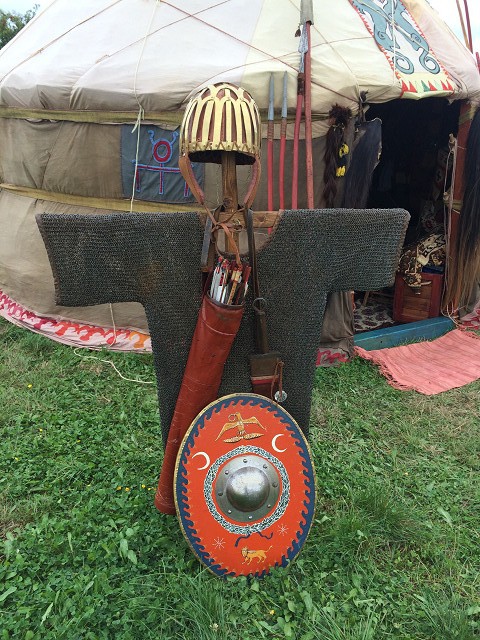 Bows, Arrows and Quiver
Bows, Arrows and Quiver
From the 1st century AD the Scythian short reflex bow was replaced by the so-called “Huns” bow. The new bow shape is characterized by bony fittings on limb, an asymmetrical shape and a considerable length, which could reach the unstressed state up to 120 cm. But the Sarmatians apparently used the short Scythian and longer Hun bow parallel up to the 4th century AD. For our reconstruction of a Sarmatian auxiliary, we have resorted to a “Hun” form, which is large and equipped with long limbs. In Sarmatian graves red and blue-red painted arrow shafts have been found, which we have taken up. The arrowheads were mainly triptychand made of bronze or iron. read on...
Literature:
Simonenko 2001: 189-202.
 Lance and Javelins
Lance and Javelins
Spearheads of the Sarmatian nomads of the Black Sea region are usually of rhombic shape and about 20 to 25 cm long. Pictures show Sarmatian lances of partially enormous length, but so far no such findings were made in complete condition. However, one can deduce based on the location of the spearheads in the grave pits of a maximum length of 2.5 meter that Sarmatian lances didn’t exceed this maximum length. Perhaps the lances were also broken, before they were put into the grave, so longer shafts are also conceivable. So about the absolute length of Sarmatian lances finally no reliable indication can be made, but it must have dependent on the military utility of heavy or light cavalry. For an auxiliary, which should be used primarily as an archer, a relatively short spear could therefore have been sufficient. In addition, peaks of javelins were found in few Sarmatian graves, which could have added the equipment of mounted warriors.read on...
Literature:
Simonenko 2001: 208f.
 Helmet (Stanica Tbilisskaya, Kurgan 6, 2nd half of the 2nd century BC)
Helmet (Stanica Tbilisskaya, Kurgan 6, 2nd half of the 2nd century BC)
This so-called “skeleton helmet” is a hitherto unique find and represents one of the few helmet finds ever in the Sarmatian milieu. Its construction method is interesting. It consists of different shaped bronze strips which are respectively held together by iron rivets. Loop pairs on the sides of the end hoop and a chain on the neck indicate now decayed helmet utilties, whose exact form one can only speculate. We opted for the application of cheek pieces of leather and textile, and added a byrnie of leather plates. Similarly, we filled the gaps between the metal strips with a thick layer of felt and leather since the helmet would otherwise have had little protective effect.read on...
Literature:
Simonenko 2001: 263f., 265.
Schiltz 2001: 248.
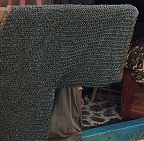 Chain Mail
Chain Mail
This armor shape is found from the 1st century AD increasingly in Sarmatian graves and appears in the 1st century BC in almost all graves. How these kind of arms attained to the Sarmatians, is still unclear. Presumably it did not originated in the nomadic milieu, but was taken over by the Celts or later by the Romans. The chain mail was mainly made of iron, but recognized also partly ornaments or integrated ring mesh made of bronze. The rings had up to 1 cm in diameter and were at least partly riveted. We opted for the so-called Roman mail with a ring diameter of 0.6 cm.read on...
Literature:
Simonenko 2001: 277-279.
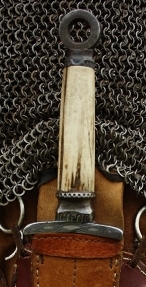 Dagger
Dagger
Ring pommel daggers were widespread among the Sarmatians. They were worn in a characteristic dagger sheath, which was held by four semicircular plates and fixed thereto with straps on the thigh. What is interesting about this attachment mechanism is that it was not known at the beginning of the Iron Age, but was also to be widely used in the East. From Sarmatian time only pieces made of gold and especially ornate with gems have survived, while in addition some pictures of grave steles also show this dagger form. For a simple auxiliary, we have chosen a simple iron ring Dagger with leather sheath, although it has no specific archaeological template, but is geared to the pictures and better suited to the representation selected by us.read on...
Literature:
Tolstikov 2013: 222
Trofimova 2007: 182.
Simoneko 1991: 215-220.
Wieczorek und Lind 2007: 295.
Deutsches Archäologisches Institut u.a. 2007: 154.
Simonenko 2001: 219-225.
 Ring Pommel Sword and Sword Pearl
Ring Pommel Sword and Sword Pearl
Ring pommel swords are the dominant type of swords in the North Pontic area of 1st -2nd century AD. Although they occur in many forms and variations, mostly 33-46 cm long and thus correspond to a short sword. The blade tapers either from the handle or only at the blade tip and is usually 4 to 5 cm wide with lenticular section. The guard is almost always formed straight. The handle was mostly between 2 and 3 cm wide, in cross-section rectangular or oval and could either tapering or run parallel to the pommel. The diameter of the supervisory round-shaped pommel was always about 5 cm at 0.5 to 1 cm thickness.weiterlesen...
Literature:
Simonenko 2001: 219-225.
Krosigk 2005: 110-133.



